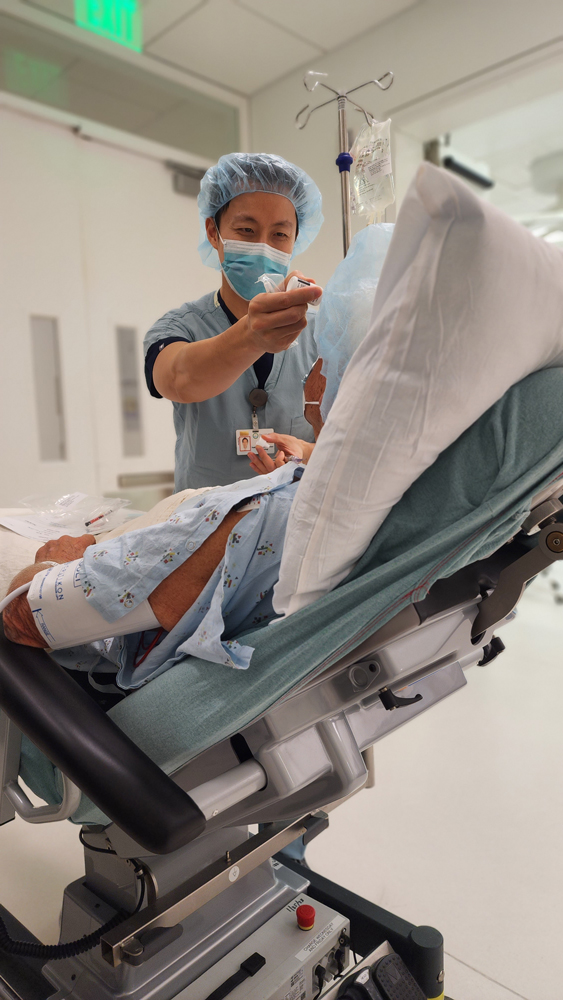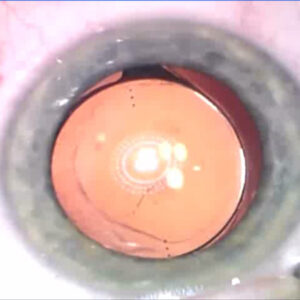Cataract
December 2023
by Liz Hillman
Editorial Co-Director
Anxiety is common among patients headed into the OR for cataract surgery, but when anxiety turns into agitation, it could mean a higher risk for intraoperative complications or a delay in surgery.

Source: Shawn Lin, MD
“At least 10% [of patients] can become anxious or agitated. This can take many forms, from a patient shaking their leg to something more drastic such as suddenly moving their head,” said Shawn Lin, MD.
Rosa Braga-Mele, MD, further differentiated. She also said she thinks anxiety occurs in 10–20% of cases, while 5% of patients experience some disinhibition and 1% reach true agitation. “It’s a spectrum,” Dr. Braga-Mele said. “Agitation itself is very rare. It’s a whole spectrum of anxiety, disinhibition, agitation.”
The anxiety spectrum
Anxiety is normal and experienced to some level by all patients who are fearful of the operation. Dr. Braga-Mele said anxiousness can be controlled with more medications or verbal anesthesia (talking to the patient before and during the surgery about what to expect and what’s going on).
Disinhibition is when the person is not entirely in control of their faculties, she continued, and can occur with too much medication, due to patient personalities or pre-existing conditions, or how they react to medication. Working with anesthesia, handholding, and gentle verbal anesthesia is helpful in these situations.
Agitation occurs when the patient is out of control to a point where surgery needs to stop temporarily or be postponed entirely for patient safety. When a patient becomes truly agitated, Dr. Lin said it’s often too late for anesthesia to make efficient adjustments for the case.
“The key is to recognize it early enough to come out of the eye before the real agitation occurs,” Dr. Braga-Mele said. “Deal with the agitation, talk to the patient before you go back into the eye. Don’t try to deal with agitation while you’re in the middle of doing phaco because they may move.”
Preventative medicine
Dr. Lin said he thinks the most important thing to alleviate anxiety and help avoid true agitation in the OR is prevention and setting expectations. “I talk to patients outside of the room, get them comfortable, get them to laugh, loosen them up a bit. I tell them it’s almost like a concert: There is a light show, music, and they’re going to have a couple of glasses of wine,” he said. “I try to set the expectation of what they’re going to experience in a positive light.”
He said that expectation setting is especially important on the second eye. “I find that discomfort is about two to three times higher on the second eye,” he said. “They expect that everything is going to feel the same, but they essentially have perioperative amnesia due to the medications they received during the first surgery. I like to tell them that the second eye will feel like a completely different surgery, and they will likely perceive the whole thing as a brand new experience.”
Dr. Lin said this is an area he is actively researching, seeking to figure out what actions by the surgeon, anesthesiologist, and support team might help patients be less anxious or agitated during the second eye surgery.
“I’ve thought about giving patients a sheet of paper in the preoperative area when they arrive for their second eye surgery to let them know that the second eye will feel different than the first eye, to ensure they get the message in multiple ways,” he said. Dr. Lin and his team also send text messages and emails to patients prior to surgery, telling them what to expect.
“We smother them with attention to let them know we care and are thinking of them. This can be helpful to alleviate some of their anxiety, and hopefully that leads to less agitation during the surgery,” he said.’
Dr. Braga-Mele said there are some patients who are more likely to become agitated in the OR. Older patients and those with any form of dementia or cognitive conditions are more likely to experience agitation under anesthesia.
“Sometimes it’s better, if the patient is reasonable, to go with no sedation at all and use topical and verbal anesthesia. Keep them informed throughout the case so their anxiety lessens,” Dr. Braga-Mele said, adding that she talks throughout almost the entire case.
She also said that she tapes around the patient’s forehead to the OR bed, with prior consent, which prevents movement, and in some cases, actually alleviates patient anxiety if they’re fearful they are going to move during the case.
What to do
If a patient becomes significantly disinhibited or agitated to the point where surgery needs to pause, Dr. Braga-Mele said the surgeon needs to stay as calm as possible. “The more agitated you become, the more agitated the room becomes and your patient becomes, and your complication rate will go up,” she said.
She said the key is to keep talking to the patient and being soothing, letting them know what’s going on.
Dr. Braga-Mele also discussed how it’s important to not over sedate. Too much sedation can cause further memory issues in those with dementia, increase the likelihood of agitation/disinhibition, and/or cause the patient to go into a deep sleep.
“If I know my patient is asleep, I say to anesthesia, ‘Can you please hold their hand, they’re asleep.’ Then I stroke the patient on the forehead and say, ‘Wake up, you’re in surgery, we’re doing your eye surgery.’ Again, it’s that verbal anesthesia,” she said. “A lot of times I’ve had patients wake up completely oblivious to where they are if they are very sensitive to the anesthesia.”
Dr. Lin reiterated that if the first eye was a challenge—the patient was anxious or agitated during the case—be prepared for a similar experience with the second eye, setting expectations beforehand, giving patients plenty of verbal anesthesia during the case, and working with the anesthesia team for the appropriate medications.
“They’re always going to have some level of anxiety and sometimes agitation about the experience being different, so I think preparation is most important,” he said.
ARTICLE SIDEBAR
Close calls
Dr. Braga-Mele shared two cases where patients became significantly disinhibited or agitated.
In one, 26 years ago when she was a resident, the patient sat straight up, swerving around the operating microscope, while Dr. Braga-Mele had a cystotome in the eye and was creating the capsulorhexis. Thankfully, they were able to carefully guide the patient back down. The case proceeded normally with no complications.
“That’s when I started taping around the patient’s forehead to the OR bed,” she said, noting it’s with prior consent.
She shared another case where the patient was severely claustrophobic under the drape. This was true agitation, and the case was ultimately aborted for a later date under general anesthesia.
“The minute I put the drape on, even with conscious sedation, [the patient] screamed and fought and pushed, and I could not deal with it. She could not have the drape on,” Dr. Braga-Mele said of the one patient in her career of 20,000+ patients where she had to abort the case.
About the physicians
Rosa Braga-Mele, MD
Professor of Ophthalmology
University of Toronto
Toronto, Canada
Shawn Lin, MD
Assistant Professor of Cataract and Refractive Surgery
Associate Residency Program Director
Medical Director
UCLA Stein Eye Center Calabasas
Los Angles, California
Relevant disclosures
Braga-Mele: None
Lin: None
Contact
Braga-Mele: rbragamele@rogers.com
Lin: slin@jsei.ucla.edu



